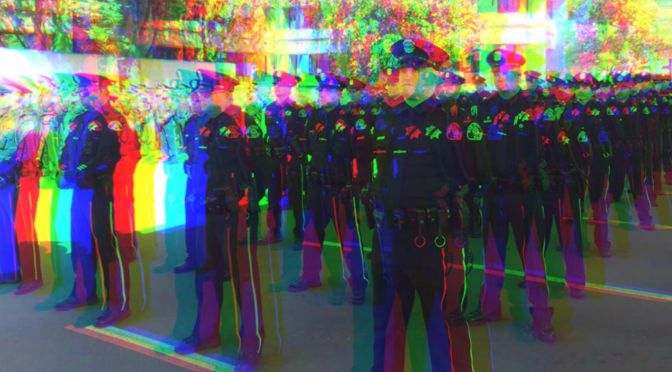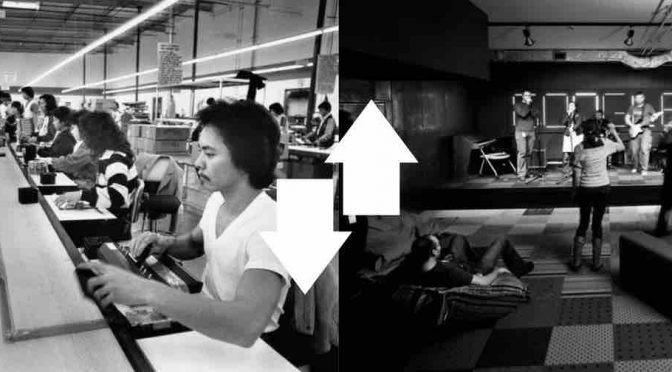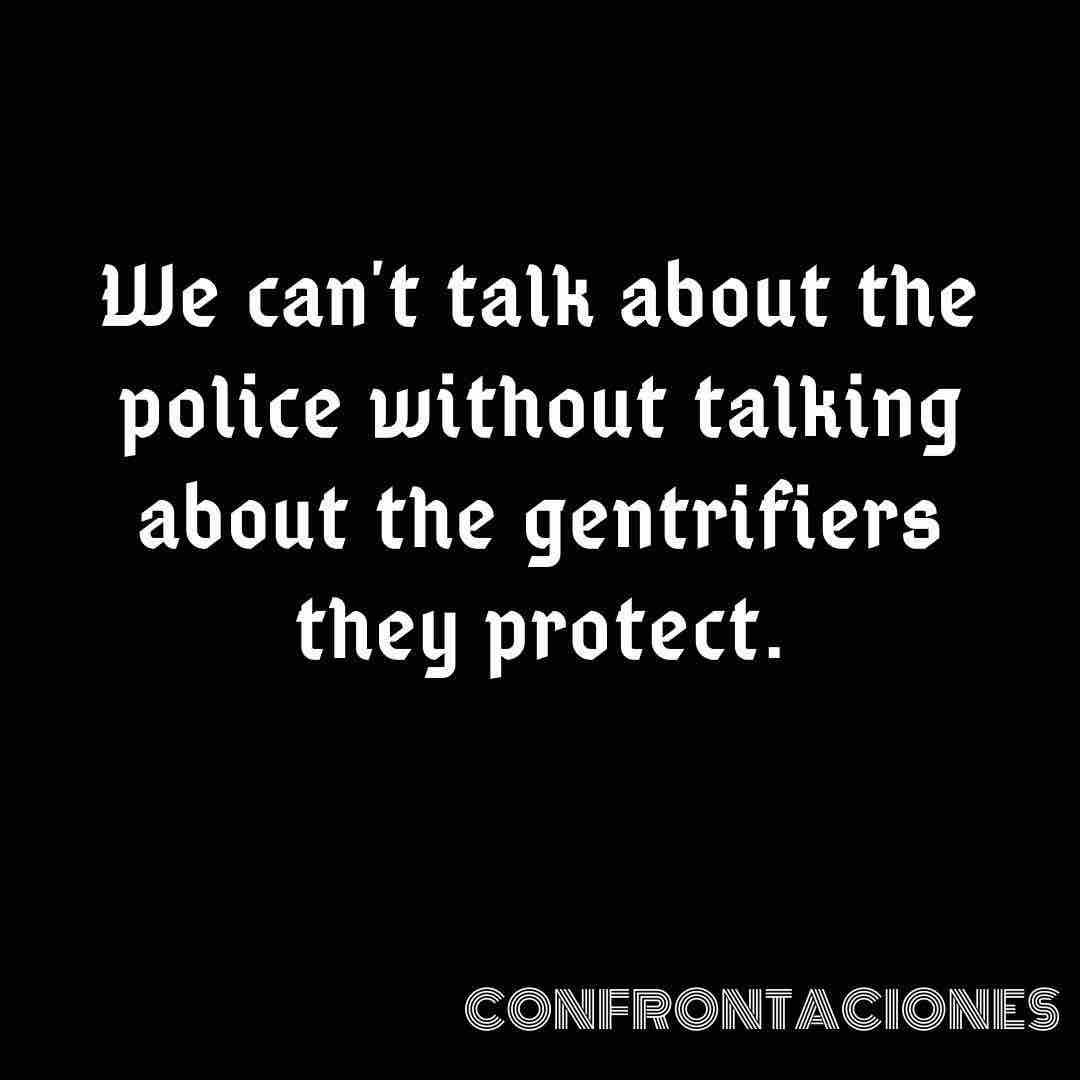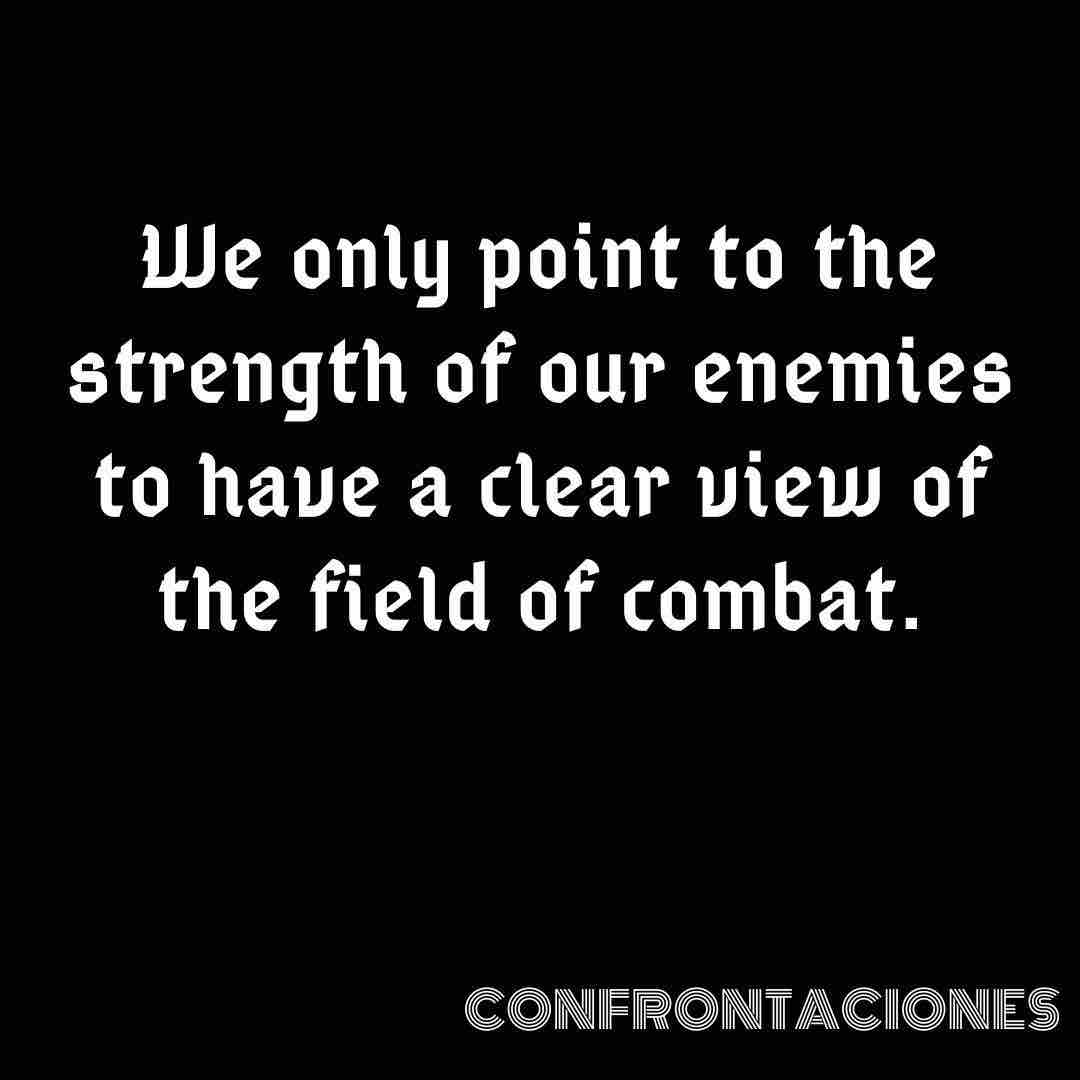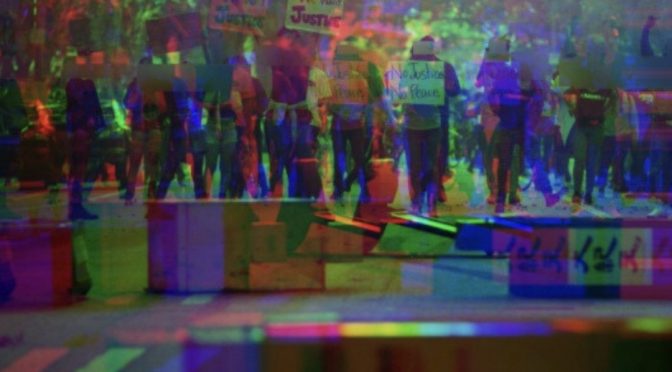The George Floyd solidarity protest, and battle with police, in San José, CA on Friday May 29th, 2020 is distinguished from subsequent demonstrations in San José by its character of revolt and traces its origins to the uprising spurred by Black Youth in Minneapolis. These qualities allowed the conflict to ascend to unprecedented levels of violence for the city. By the time of the protest, the third precinct in Minneapolis had been burned and Black rebellion had spread to cities across the so-called USA. Our thoughts on this uprising, and a following action on June 5th, provide the impetus for this project, Confrontaciones.
I: Revolt
On the 29th, a multi-racial & intergenerational assembly of outraged people come together in front of City Hall. Many are young Black folks and non-Black POC, none have any obvious affiliation with locally known activist organizations. Anonymous flyers for the rally keep many liberal elements at home over concerns related to security. As a result, standard protest programs, podiums, and speeches stay home too. Chants of “Say his name! George Floyd!” and “No Justice! No Peace!” crescendo into a march weaving through several main arteries in the downtown area, immobilizing traffic, and culminating in a blockade of the 101 and 280 freeways. Law enforcement is unable to mobilize a response for close to an hour.
On the 101, car windows are smashed when some travelers attempt to force their way through the blockade, or step out of vehicles to confront demonstrators. Anyone bold enough to challenge the crowd sees their rage exceeded by youth who weren’t having it. Tensions briefly flare over the political logic of the blockade; these critiques fail to recognize the protest as a fierce response to fuck shit up (after the murder of another Black life), rather than a political reaction. SJPD learns this when demonstrators exiting the freeway confront & surround them on the overpass to smash up patrol car windows. Roughly 45 minutes after spilling into the freeway the protest had begun the march back to City Hall despite proclamations that, “This is San José, they ain’t goin to do shit!” On the way, there is a discernable sense that things are beginning to wind down. People are overheard saying “we gotta go to Oakland tonight!” (to an evening protest). A Black youth from Oakland admits “I didn’t know San Jose got down like this. After what they (Minneapolis PD) did I couldn’t wait. I had to come here too.” But the day is just getting started and the crowd that regrouped at City Hall is met by tear gas, rubber bullets, and an LRAD, barbarity which shocks the public into a movement to defund the SJPD. Joyous cheers erupt for a young rebel who braves a flurry of rubber bullets to throw back a tear gas canister. At this stage, in what felt like a lifetime since the start of the battle, there are almost no voices in the rebel ranks promoting “peace.” A bystander recording events on their phone takes a rubber bullet to the eye; nearby another is vomiting after inhaling tear gas. Throughout the battle people tend to each other’s wounds and share much needed snacks and water. Nearby, a UPS truck load is expropriated by rebels while dumpster fires are used to slow the police advance. Any who are present, whether engaged symbolic forms of protest (like taking knees) or willingly fighting the pigs, are attacked. For several hours, police effectively wear down demonstrators. Rebel measures – dumpster fires, projectiles and property damage – give pause to the highly militarized police, but are unable to sustain fighting. In total 38 arrests are reported while hundreds of complaints are filed against SJPD. Officer Jared Yuen goes viral for being unable to hide taking delight in brutalizing unarmed people, and SJPD’s own implicit bias trainer, Derrick Sanderlin, becomes national news after rubber bullet fire leaves the 27 year old needing surgery and uncertain if he will be able to have children.
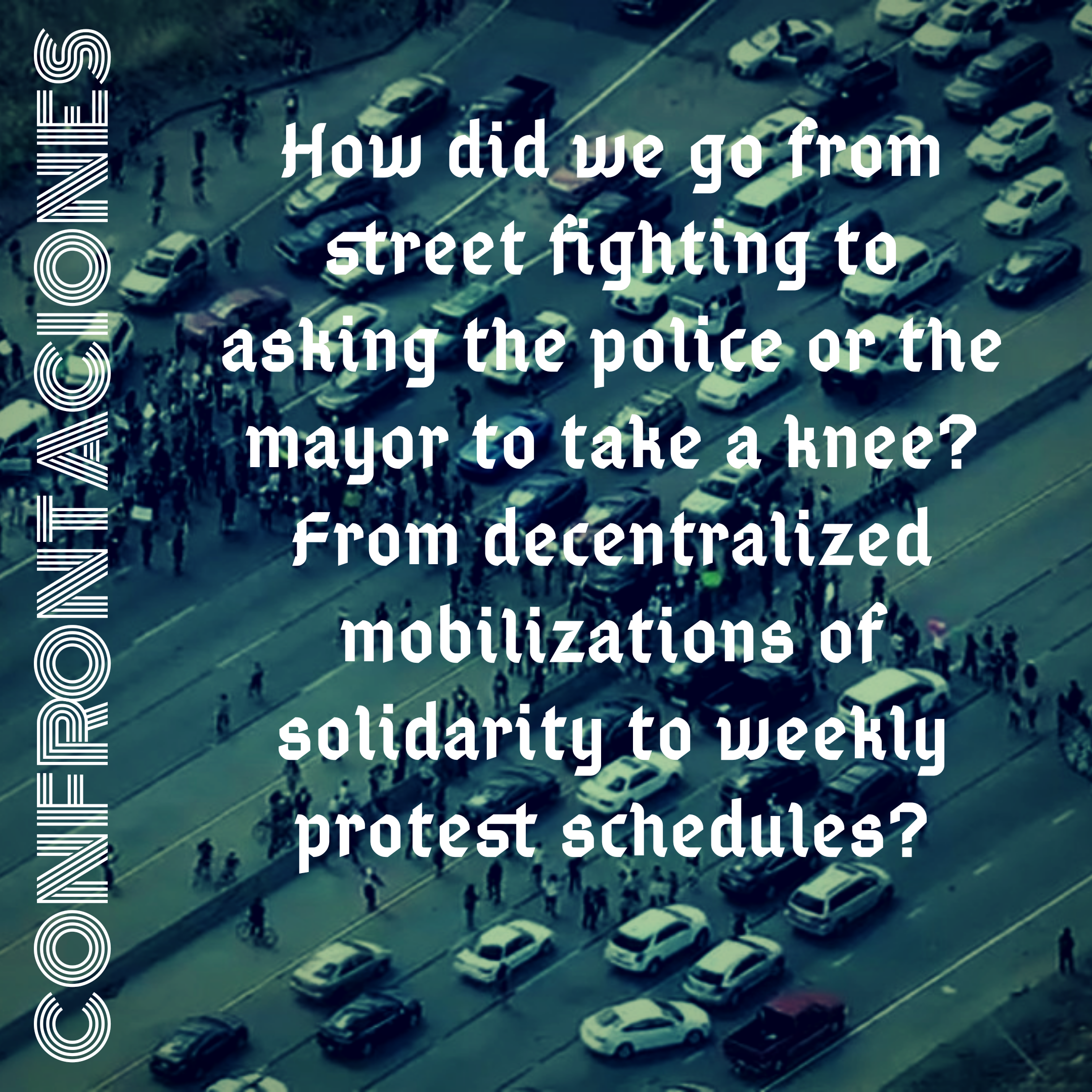
II. Retreat
A week later, Friday June 5th, thousands descend on city hall. So many attend they spill onto the street for lack of space even in the vast area in front of the government offices. Noticeably, there are no police in sight for such a large assembly (In the days after the battle of May 29th police presence had been glaring at all times and a curfew was put in effect but ended Thursday June 4th, a day before this demonstration). This time organizations are conspicuous as hell and the amphitheater in front of the building acts as a platform for speeches. Once again a multi-racial crowd gathers, but in contrast to the week prior it is a gathering satisfied with acting out non-violent liberal protest forms. We have returned to what Frantz Fanon calls “hypnotherapy of the people.” (1) The protest “leaders,” standing apart from the crowd, lead demonstrators in an orderly march which climaxes with a moment of silence and kneeling at the police station, while making no mention of the county jail imprisoning Black and Brown folks just hundreds of feet away. The march route leads through First street, a major pathway for morning travel north where many corporate offices are situated, and a path for the public rail line, but no trolleys ever come through. Police maintain distance at all times and are never really in sight.
The account of June 5th is important to the context of the preceding week’s battle because we can draw a couple conclusions from it. One, that SJPD adjusted its approach after a week of scrambling to justify officer conduct, now adopting a strategy of de-escalation by withdrawal while simultaneously repositioning repression as defensive or reactive. Two, we can also confidently deduce that some level of coordination was taking place between the city and protest managers (i.e. the rail wasn’t running). And finally, the insertion of these protest managers “conducting” the march exerted a moderating effect on the action of the 5th. A masked up crowd can light up a dumpster. A non-profit leader who applied for a demonstration permit would never promote such a thing.
From the perspective of the social justice managers and conductors and professional campaigners, this later march was certainly a success. A decentralized, ungoverned sprawl of an action was replaced by an orderly procession to an approved site of protest. There was no violence, no looting, no conflict at all.
III. Residence
How did we go from street fighting to asking police or the mayor to take a knee? From decentralized mobilizations of solidarity to weekly protest schedules? And why is this backpedal significant? For starters, the pandemic appears to be here to stay and continues infecting the most vulnerable among us and forcing millions into economic precarity. At every turn the government responds with ineffective measures, and loses trust and legitimacy as the guarantor of health & safety. In this age of technological innovation and abundance, it might seem ridiculous for the whole thing to collapse under a tsunami screaming “ACAB”, but for the hungry person who cannot take refuge from a deadly virus, such abstractions are meaningless. The next wave of struggle is imminent. When the time comes, how can we foster and widen local revolt? Answers, action schemas, require an examination of where we are.
The self-proclaimed capital of the Silicon Valley and 10th largest city in the US, San Jose, rests at the southern end of the San Francisco Bay Area on stolen Tamyen Ohlone Land. From Indigenous Ohlone resistance against Spanish colonization, to labor struggles in the orchard canneries and later electronics industries, the region has been shaped by courageous examples of struggle. However, it is commonly understood, even within the Bay, if you want to get down, you go to the Town (Oakland) or the City (SF). Recent years have witnessed a rise in subversion, including a near-riot in protest of a Donald Trump rally in 2016 and grassroots efforts to derail the construction of a Google mega-campus, but the events of May 29th surprised many, due in large part to tech-funded non-profit hegemony in the city’s political culture. Social justice and community organizing are largely the domain of these institutions.
Known for its immense wealth to those outside, the Silicon Valley is in fact home to severe inequality and unaffordable living costs causing rising homelessness, gentrification & mass displacement from the region. There are two Silicon Valleys, one where proles sustain themselves holding multiple jobs and cramming into scarce housing and another where wealthy elites prosper in an environment homogenizing in perpetuity to accommodate their desires. These racialized groups tell the story of white supremacy, a contradiction of the liberal & diverse outward facade the city enjoys.

Despite San Jose’s reputation as safe big city with crime rates on the decline for decades, San Jose’s Police are responsible for the most fatal encounters of any Bay Area city since 2015 (2) – they have committed several murders of unarmed people that remain unacknowledged by city leadership even as they join in symbolic gestures of solidarity for people killed by police in other cities. The police are among the highest paid public employees in the city as city government and private partners are driving expansive efforts to redevelop and urbanize swaths of the city’s sprawling suburbs to attract big investors in the midst of a crushing housing crisis.
Those most affected by local outcomes are excluded from participation in any cardboard cutout democracy by virtue of being too poor and too busy, and when their hardship puts any kind of damper on all the prosperity it is police who sweep homeless encampments, enforce evictions and terrorize criminalized POC. Folks with the most to gain from the destruction of the status quo are being expelled from region and the economy altogether. Clinging to programs developed a century ago (with a vital class-conscious working class in mind) to confront these trends is a failure to recognize this reversal of industrial organization and a path to defeat.
Why? In Silicon Valley, assembly lines are gone; workers now labor for unnamed bosses with the click of an app button—it’s hailed as the gig economy. The time is always right for struggle and those among us speaking of reform or cultivating revolution through radical literacy employ the tongue of the state and privilege. Indignation against the current order is abundant and plain to see in the heightened frequency at which we move from uprising to uprising, so the task of the radical milieu in San José, as well as abroad, isn’t vanguardist work to create revolt or enlist the masses, but to develop and disseminate measures for our collective liberation. When the tension Power carefully manages – through minor concessions bearing major names – to limit social unrest. When it reaches its breaking point, we must be at the ready to provide the extra push.
IV: Revolution
In the post-mortem of May 29, the police chief issued statements describing “an insurrection of pre-planned violence the likes of which I have not seen in my time wearing this uniform.” It is a blatant distortion of reality from a man scrambling to rationalize the barbarity unleashed on protestors by his goons, but one admitting fragility, even as it dodges accountability. The battle of May 29th exceeded even the most optimistic prognosis of what would unfold that day and yet could’ve gone further, because while SJPD demonstrated it was on unfamiliar ground, the dominance of non-violent liberal protest culture in San José also reared its head. Report backs from other cities have communicated how diverse tactics can overwhelm police and confuse them. Individuals acting autonomously protected by the power of the protest have shown the potential to raze cities, and when reflecting on the battle that took place in San José, this potential appeared to be within reach. Without question the police and state have realized this and will reorganize to emerge stronger than before.
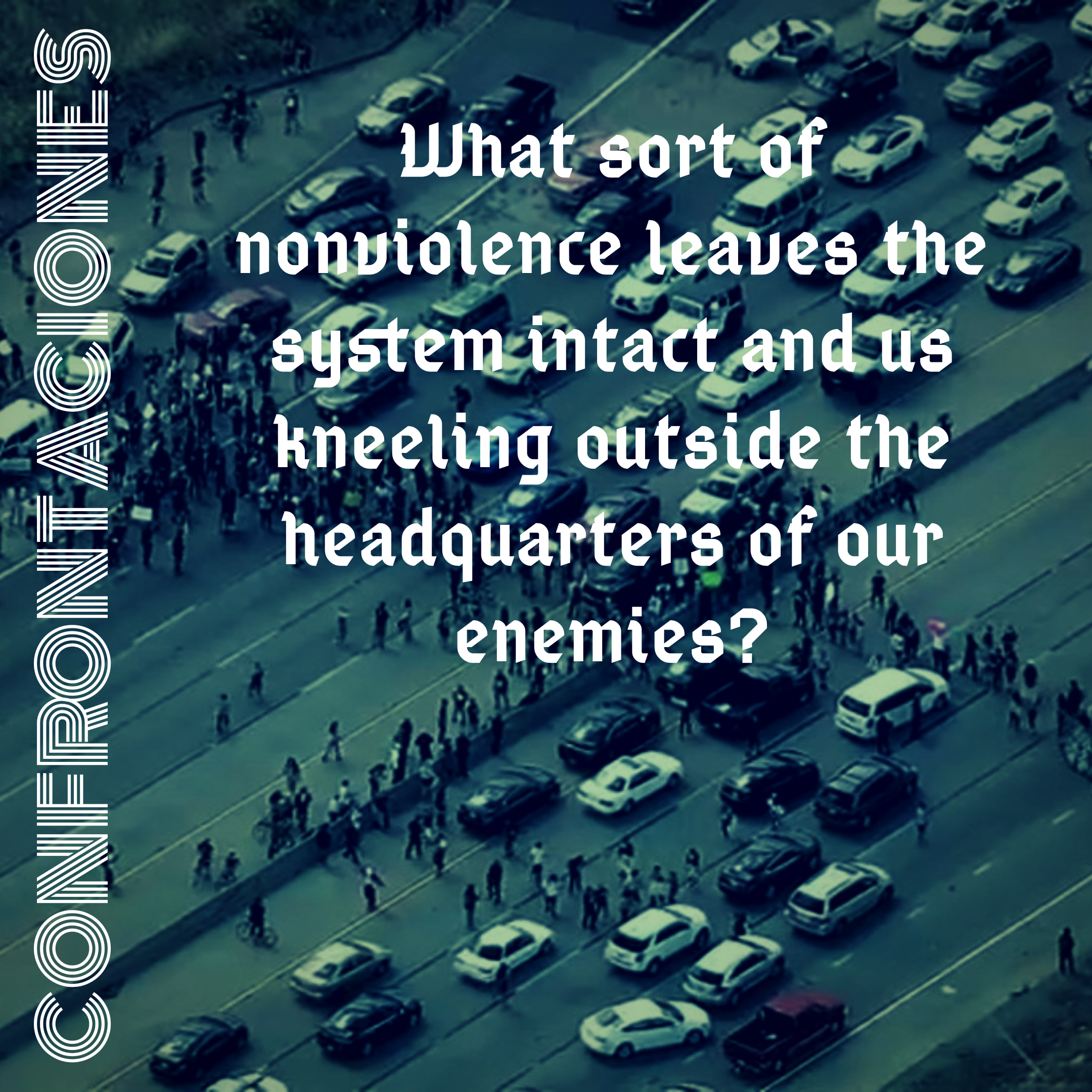
From the perspective of someone who wants to see this anti-Black world come apart, we must ask what non-violence truly means. Does it mean ensuring that our actions don’t tarnish the windows and newspaper boxes of the corporations? Or, given the mechanized brutality of our opponents, does true non-violence mean taking whichever tactics pose the greatest threat to the police and the empire? What sort of non-violence leaves the system intact and us kneeling outside the headquarters of our enemies? The rebellion of May 29th shut down our city as was relayed to militants around the country and the world. From this perspective, the perspective of winning, the perspective of destroying those things that destroy us, the stage-managed demonstration a week later was in fact a huge step back. We remember the words of Black anarchist Lucy Parsons when she said, “Most anarchists believe the coming change can only come through a revolution… Still we are willing to work for peace at any price, except at the price of liberty.” Those taken in by the reformist and deformed world of non-profit campaigning seem to wish to work for liberty at any price, except at the price of a deadly social “peace.”
Not one more step that isn’t forward or on the throat of our enemies. Toppling this world is the task at hand and we must build capacity to see revolt through to its radical conclusions. To hell with this anti-Black, white supremacist, patriarchal, capitalist world. Fuck the police and their dead homies!
– A pissed off Prole who got down
[1] Frantz Fanon, “The Wretched of the Earth, On Violence”
[2] San José Mercury News, June 28,2020: “Blacks are only 7% of the Bay Area, but 27% of those killed by police”
Another account of events can be found at: https://itsgoingdown.org/reportback-from-san-jose-may/


